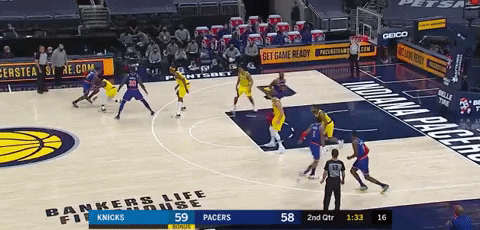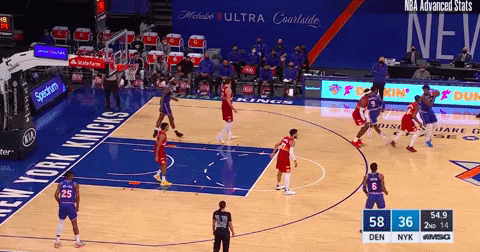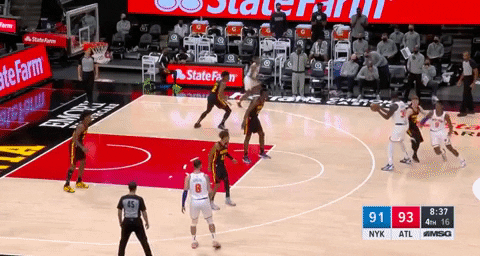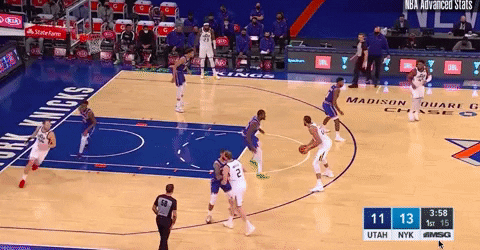RAC Attack
Tom Piccolo takes a look at the Knicks ultimate wild card this season, plus a preview of Knicks vs Nets, Round 1
Good Morning! Today, Tom Piccolo makes his return to KFS with a look at the gift and the curse of lineups that feature Julius Randle at center, but first, a quick preview of Knicks vs Nets from me:
Game Preview: Brooklyn at New York
⌚️ When: 7:30 pm
📍 Where: MSG
🤕 Who’s Out: Reggie Bullock has been listed as doubtful for New York, so he’ll likely join Obi Toppin, Alec Burks and Frank Ntilikina on the sidelines once more.
↩️ Last Night: The Nets beat the Nuggets by six in Brooklyn behind 34 points (on just 18 shots), 13 dimes and nine boards from KD. Old friend DeAndre Jordan, meanwhile, registered his first DNP-CD of the season.
🔙 Recent History: The Knicks are 11-9 against the Nets over the last five years, splitting the four games in 2019-20 and in three of the last five seasons. New York actually swept Brooklyn in Jeff Hornacek’s final year, the last time the Knicks swept a four-game season series from anyone, and one of only five times they’ve swept a multi-game season set in the last three campaigns.
🌉 Where Brooklyn At? Despite a 6-6 record, the Nets have the 3rd best rating in the NBA, the result of several blowouts amongst their wins and a number of close loses.
In terms of who’s been producing for Steve Nash’s squad, their two best players by on/off net rating - Spencer Dinwiddie (ACL) and Kyrie Irving (WTF) - are out, but that KD dude is still very much present, and Brooklyn has been outscoring teams by 14.9 points per 100 possessions when he’s been on the court.
News & Notes
According to Marc J. Spears, the Knicks have hired Gene Cross as a college scout. Cross was previously the Amateur Scouting Director for the Kings. Cross has a long coaching career in college and the G-League, mostly as an assistant, until his beginning his most recent stint with the Kings in 2018.
Meanwhile in Houston, the James Harden situation took another turn when Harden hit the podium following the Rockets’ second straight blowout loss to the Lakers, saying Houston is “just not good enough ... I love this city. I literally have done everything that I can. I mean, this situation is crazy. It’s something that I don’t think can be fixed” before walking off. Later on, John Wall added that it’s hard “when you have certain guys that don’t want to buy in.” I’ll have more thoughts on this later in the week.
RAC Attack
by Tom Piccolo
With just under 10 minutes left in the fourth quarter of the Knicks’ home loss to the Oklahoma City Thunder, Julius Randle entered the game for Nerlens Noel and remained at center until the final buzzer. In the ensuing 9:57, the Knicks were outscored 28-24, allowing the Thunder to shoot 10-of-16 from the field while being out-rebounded 13-6. There were times when even OKC seemed a little shocked at just how wide open the paint was:
Those results were enough for many Knicks fans, myself included, to question Tom Thibodeau’s decision to sit Mitchell Robinson for the entire final period. In his post game presser, Thibodeau tried to justify his decision:
We were just trying to get something going offensively, so we went small to try and generate more offense, and we’ve done it in the past and we’ve gotten some good results.
That Thibs showed a willingness to tinker and try something different is a good thing. Knicks fans had many reasons to question last season’s coaching decisions, but David Fizdale’s aversion to playing Randle at center was always particularly head-scratching, especially given the team’s lack of spacing. That 2019-20 team ranked dead-last in three-point attempt rate and finished 28th in three-point percentage, per Cleaning The Glass. Despite that, in his 64 games played, Randle spent only 5% of last season’s minutes at center, the lowest mark since his 2015-16 season in Los Angeles. As a result, Randle was left barreling into mosh pits of defenders, his own teammates and probably even a few referees.
In the early going of this season, Thibodeau has had more of an appetite for playing Randle as the lone big. Through 11 games, 16 percent of Randle’s minutes (136 possessions) have come at the center position. Part of that has been out of necessity. Noel missed a couple games with a sprained left ankle and sore left knee; Omari Spellman was dealing with right knee soreness and, frankly, didn’t look good enough to crack the rotation. But, perhaps more notably, you too would find any excuse at your disposal to keep Randle in the game this season. The team is +7.5 points per 100 possessions with him on the floor. He’s been consistently dominant. Sometimes coaching decisions are easy.
Now, the situation is a little different. Noel is rounding back into form; Taj Gibson should be joining the team shortly; and (hopefully) Obi Toppin will be returning soon from his right calf strain (I should note here that in Toppin’s limited minutes, Cleaning The Glass classified him as the power forward to Randle’s center). The Knicks’ front court projects to have some real depth very soon. Meanwhile, Randle’s combination of minutes and workload has brought up valid questions about whether the Knicks star is showing early signs of fatigue.
So the question becomes: Is playing Julius Randle substantial minutes at center a viable option for this team going forward?
The early results have been fairly encouraging. The Knicks are basically net neutral (-0.6 points per 100 possessions) with Randle at center (I’ll be using RAC as shorthand going forward), which is notably better than when he plays power forward (-3.8 net rating). And, unsurprisingly, the way those two lineup configurations approach the game is vastly different:
Let’s take a look at how those differences manifested on both sides of the ball.
Offense
Thibs was right about RAC lineups juicing the team’s offense. Those lineups are scoring a blistering (well, at least for the Knicks) 116.2 points per 100 possessions. When I began this research, I wondered whether RAC lineups would have higher assist percentages or better three-point shooting due to more successful drive-and-kicks. Nope, none of that fancy stuff. RAC lineups have assumed the identity of their star. That is to say, they are getting buckets the best way Julius knows how: bulldozing their way to the basket:
With RAC, the Knicks are taking 47% of their shots at the rim (up from 39.5% with Randle at PF). Can you guess how many commonly-used lineups in the entire league take a higher rate of shots at the rim? Zero.
Perhaps the biggest difference, though, has been these lineups’ ability to actually score at the rim once they get there. RAC lineups are converting on 66% of those attempts at the rim, which is comfortably above league average and substantially better than when Randle plays power forward (57%). Getting even more granular, the Knicks shoot about 65% on layups with RAC compared to just 48% with Randle at power forward, per NBAWowy!
But, here’s the weird part. Randle’s own accuracy at the rim actually drops a couple percentage points when he plays center. It’s everybody else who benefits from the added spacing. The player who gains the most from that extra room? You probably guessed it: RJ Barrett. On the season, Barrett has a ghastly True Shooting Percentage of 43.3%. Of the 97 players to take at least 100 shot attempts this season, Barrett ranks 95th in TS%. However, when Randle is at the five, Barrett’s TS% skyrockets to 75% per NBA Wowy, including an astonishing 81.3% on two-pointers (sample: 109 possessions).
Am I confident that RJ Barrett will continue to be the second coming of Wilt Chamberlain in RAC lineups? Unlikely. I’m sure there is some small sample noise in these numbers, but it’s hard to ignore how much more comfortable RJ looks with a little bit of breathing room out there:
Given how often RAC lineups attack the rim, it may not surprise you that they get to the line a ridiculous amount, earning a free throw attempt rate of 32.4%. I’ll give you another guess on how many regularly-used NBA lineups get to the stripe that often. Zero.
Watch as the Knicks spread the floor and run a post-up for Randle against Indiana’s Domantas Sabonis which resulted in an and-one:
This play shows how having even just two shooters on the court can make a difference. Look how nicely the Knicks space the floor. You can see Reggie Bullock go to nudge Kevin Knox up above the break, but Knox is already sliding. Randle’s quick decision to attack doesn’t allow for the Pacers’ defense to adjust and help properly. RJ Barrett sees his defender turn his head and makes a nice cut, knowing Randle’s penchant for interior passing. Knox even fills for Barrett, further helping the spacing should Randle have kicked it out.
The other most significant change with RAC lineups is frequency of turnovers. With Randle at PF, the Knicks cough up the ball A LOT: 18.6% of their possessions, worse than 98% of lineups. With RAC, that number falls drastically to 12.5%, among the best marks in the league.
It’s not hard to imagine why. Teams are getting smarter about completely ignoring the Knicks’ non-shooters like Elfrid Payton and RJ Barrett to pack the paint. Watch as Randle goes to make his pass here, he’s met by three defenders in the paint.
Compare that to the space here:
When the pass was made, there were 1.5 defenders in the paint. Granted, Knox’s man left him pretty early, but not before the pass was already cleanly caught with Barrett able to take two steps and go up strong.
RAC lineups also play with a faster pace, getting out in transition more frequently and pushing more often on defensive rebounds. So, to recap: when Randle plays center, the Knicks offense:
Gets to the rim more often
Scores more efficiently on those shots at the rim
Gets to the free throw line more frequently
Turns the ball over less despite playing at a faster pace
Gets more easy looks in transition
OK, there must be a catch coming up here somewhere, right?
Defense
You saw that nifty table above showing that the Knicks give up ~10 more points per 100 possessions in RAC lineups. The reason why is probably the most intuitive thing you’ll read today: they hemorrhage shots at the rim. Here’s another helpful chart with stats courtesy of CTG:
RAC lineups give up way fewer three-pointers, both above-the-break and from the corner compared to when Randle plays power forward. Neither lineup configuration forces opponents to take many mid-rangers, so it appears that most of those threes just become shots at the rim.
This difference can mostly be attributed to Mitchell Robinson who is far and away the Knicks most impactful defensive player. Randle, on the other hand, lacks the height, length, bounce, motor and instincts to be a real deterrent in the paint, as we can see here:
And here again against the Jazz:
Curiously, Randle’s personal rim protection numbers haven’t been too shabby. Per NBA.com, he allows opponents to shoot just 56.1% at the rim which ranks him 24th among 51 players to defend at least 40 shots at the rim this season.
Is Julius Randle actually an above average rim protector? No. I fully expect those numbers to creep back closer to last year when he was among the worst rim protecting bigs in the league. One thing that may actually help him here is that he can sometimes be so out of position to defend the rim, that he doesn’t register as a defender on the field goal attempt at all:
Here, Randle stuck too close to Gobert, opening up the drive for Jordan Clarkson. You better believe Mitch would’ve sent that off the backboard.
The final stat I’ll bring up on the defensive end is around RAC transition defense. Regardless which position Randle plays, the Knicks allow about the same amount of transition plays to occur. However, with RAC lineups, opponents absolutely destroy the Knicks on those attempts; RAC lineups are in the 1st percentile (per CTG) in defending transition field goal attempts. Part of this is certainly effort, but it also makes sense that opponents are able to better exploit mismatches during advantage situations in transition:
Or everyone’s favorite, “Just jump, Julius!”
Given his physical limitations and the offensive burden he has to carry on a nightly basis, It’s hard to fault Randle too much for the defensive deficiencies of RAC lineups. That said, the downsides of these super-charged offensive lineups are an enormous piece of the puzzle that Thibs is tasked with putting together.
Conclusion
RAC lineups are a positively crucial part of this Knicks team’s identity. Yes, their deployment should depend on the situation (opponent, Randle’s fatigue, Mitch’s foul count, flow of the game, etc.), but they are far too valuable in unlocking Barrett and other perimeter players to ignore or minimize. Perhaps the biggest variable here is Obi Toppin’s health and development. If he can come in and be a stretch four next to Randle, it will give RAC lineups much-needed size and athleticism without sacrificing the shooting or playmaking. There’s a world where Randle spends upwards of 20% of his minutes playing the five next to power forwards like Toppin and Kevin Knox. In that world, there is space for players to move and there is space for fans to breathe.
That’s it for today! If you enjoy this newsletter and like baseball, don’t forget to subscribe for free to JB’s Metropolitan, a daily look at the Mets that gives you everything you could possibly want to know about the local baseball team.
See everyone tomorrow! #BlackLivesMatter

















I'm not convinced we learn anything when we experiment late in the game after Randle has carried the offence for the first 30 minutes.